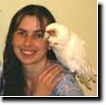Before you release your new pair of Gouldians into your existing flock you will need to complete the initial treatment for S76. This means that you need to treat them for 2 consecutive days each week for 3 consecutive weeks, and thereafter you need to treat the entire flock with S76 in their drinking water for 2 consecutive days each month. Since air-sac mites are endemic in the wild population of Gouldian Finches it should be assumed that all captive Gouldians are also infected since the original wild caught birds probably had air-sac mites. Once a bird is infected with air-sac mites, it is next to impossible to ever completely eradicate them. The nymph stage of this mite is laid in the posterior air-sac by the adult female and lives there in a dormant state for a long time. There is not a product on the market that will kill this stage of the mite living in this area of the bird. During times of stress (molting and breeding season) when the birds immune system is suppressed the nymphs will mature into adults and begin the cycle again. By treating with S76 every month you will keep the adult population of mites to a minimal number and thus prevent the symptoms that you mentioned from ever being exhibited. Keeping the adult population of mites in low numbers will also prevent suffocation of your birds from many dead mites when they are regularly treated.
There are other diseases that birds can carry that you should also be aware of before releasing your new birds into an existing flock situation. I always segregate new birds for a period of 2-3 months before allowing them direct contact with my flock. During this time the only treatment that they will receive is the S76 treatments for 3 weeks for air-sac mites, but I observe their droppings everyday because this is the best way, short of having culture testing of the droppings by an avian vet, to tell if there is anything else that the new birds should be treated for. When I am confident that the new birds are healthy, then I will release them into the flight cages with other birds.
But be aware that there are diseases that a bird can carry that will not be evident in the droppings and you will never know that they are present no matter how long the birds are kept in quarantine as you will not see any outward symptoms. But once these diseases are transmitted to other birds, problems could develop. Such diseases would be Campylobacter and Cochlosoma that can be carried by Society Finches that will infect and kill baby Gouldian chicks, and Ornithosis that will cause breeding problems in your flock (dead in shell, infertility and a lack of a breeding response in some birds). Polyomavirus is another real concern that can be carried by finches that can infect and kill baby birds that come in contact with the carrier birds.





